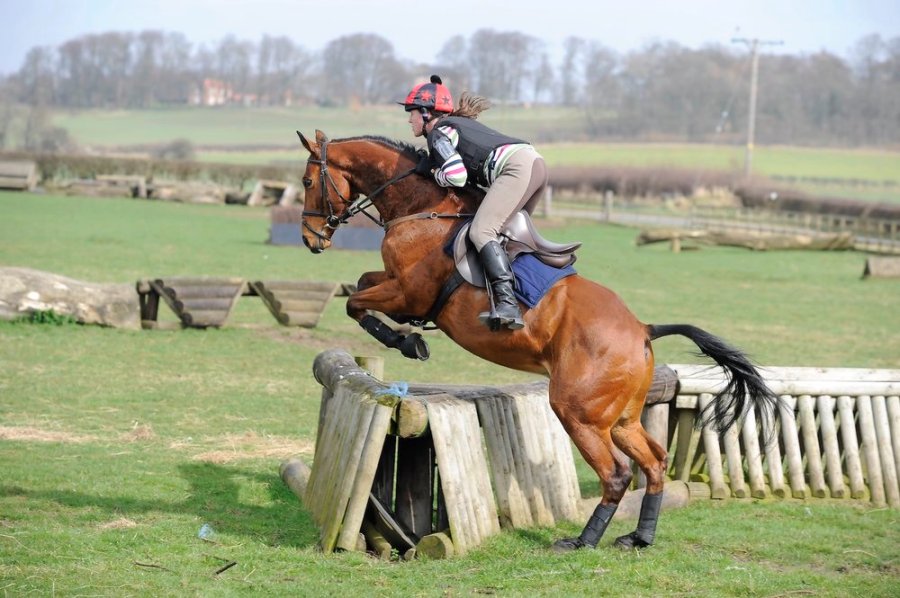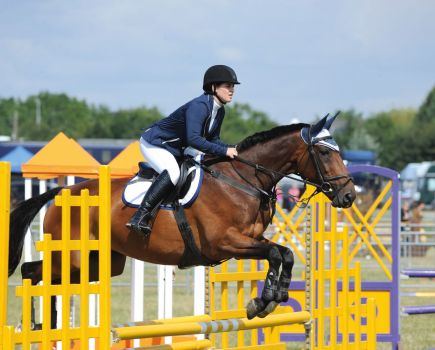Warming up with Harry
To help you warm your horse up for a cross-country schooling session, we’ve asked eventer Harry Meade for his advice. “Warming up in an open field can be daunting for a lot of riders and, as a result, many warm up on a tight circle in the corner of a field,” says Harry.
“However, the first principle of cross-country is to get your horse to travel from A to B. So warm up around the outside of the field, otherwise your horse will feel as though he’s spiralling down a plug hole if you ride constantly in circles.”
To warm up effectively, follow Harry’s four-step approach:
Step 1 Start in a purposeful walk, and think ‘straightness’ as you encourage your horse to relax.
If you come across any small water complexes ask your horse to quietly,
but confidently, walk through them on a loose rein.
Step 2 Pick up trot and, as you ride round the outside of the field, introduce a jump over a shallow ditch or up a small step, making sure your horse is in front of your leg.
Step 3 Next, in a relaxed canter, with your horse in front of your leg, ride with your reins bridged across his lower neck and with your weight off his back. Your horse should be relaxed and working in a forward canter without tension.
Step 4 Finally, as part of your horse’s warm-up and before you jump a small course, string six small, basic fences together in a simple route. Approach with a loose rein, but don’t lose the contact.
Learn to love ‘scary’ fences with Karen
Fear is a big problem for riders when it comes to riding cross-country. “When a rider’s frightened of a fence, they often change their riding style, which sends alarm signals to their horse, in turn lowering his confidence,” says Karen Dixon.
“The rider might drop their hands, allowing their horse to abandon ship and refuse in front of the fence. Because of this, a vicious circle forms, as the horse needs the confidence from the rider to jump clear. The key to resolving the issue is to ride consistently and correctly, mentally treating trickier fences as the easier ones.”
As Karen explains, there are numerous methods you can use to tackle some of the most common rider-frighteners on a course. So read on to find out how to build your confidence – and your horse’s – by simulating cross-country jumps at home. Read on for Karen’s help and soon you’ll be tackling ‘problem’ fences, such as corners and ditches, with ease.
Clear corners in style
“When approaching a corner fence, ride in a slow rhythm, riding from your leg into your hand,” explains Karen. “If you’re approaching a left-hand corner fence (where the corner point is on the left), make sure your whip
is in your left hand, at his shoulder, so you can give him a quick tap if he tries to escape to the left. To give your horse that little bit of added encouragement, apply pressure with your left leg, keeping him in line with the fence. It also helps to look to the right, altering the direction of your upper body and weight.”
Practise at home
To work on corner fences at home, start by placing a barrel on its side underneath a small upright (see below left). “As you approach, ride it no different than you would a normal straight bar, aiming for the centre,” says Karen. “Keep your horse in front of your leg so he travels forwards.
“The purpose of jumping a barrel in the centre of the fence first is to ensure your horse is comfortable with it before you place the barrel at the side of the jump to make a corner fence.
“Once your horse is confident clearing the barrel, move it to the side of the fence. Now you can develop the fence into a spread and form a corner fence by placing another pole on top of the barrel (see below right).
“You need to ride this fence accurately, taking the right line so you jump the smaller angle of the fence, and making sure your horse doesn’t drift out to the side. This is where it’s vital you keep the rein contact, so don’t ride on a loose rein.
“As your horse becomes bolder, you can widen the poles to increase the spread. This exercise encourages your horse to tackle corners with confidence, learning where his boundaries are in terms of where to jump.”
Don’t miss the latest issue of Your Horse Magazine, jam-packed with training and veterinary advice, horse-care tips and the latest equestrian products available on shop shelves, on sale now.









